Can I Put Bottled Water In My Turtle Tank?
Many turtle owners get baffled when it comes to using the best water source for their pets. They select various kinds of water, among which bottled water is a notable one. But questioning the safety of this water type, some ponder, “can I put bottled water in my turtle tank?”
The short answer to this question is yes; you can. But every bottled water isn’t safe for use, and this is not always recommended. However, if you want to, there are a couple of facts (like pH and nitrate level) to consider when utilizing bottled water.
In this guide, we have described everything about the bottled water that turtle lovers want to pour into their tanks. So, let’s dive in.
Read more about turtles blog:
The Ideal Turtle Tank Water: Facts You Need To Consider Before Using Bottled Water
The ideal turtle tank water for your pet turtles is the key to their health and well-being. The wrong water can cause various problems, from illness to death. So, before anything else, let us check the important factors that need to be considered when using bottled water for a turtle tank:
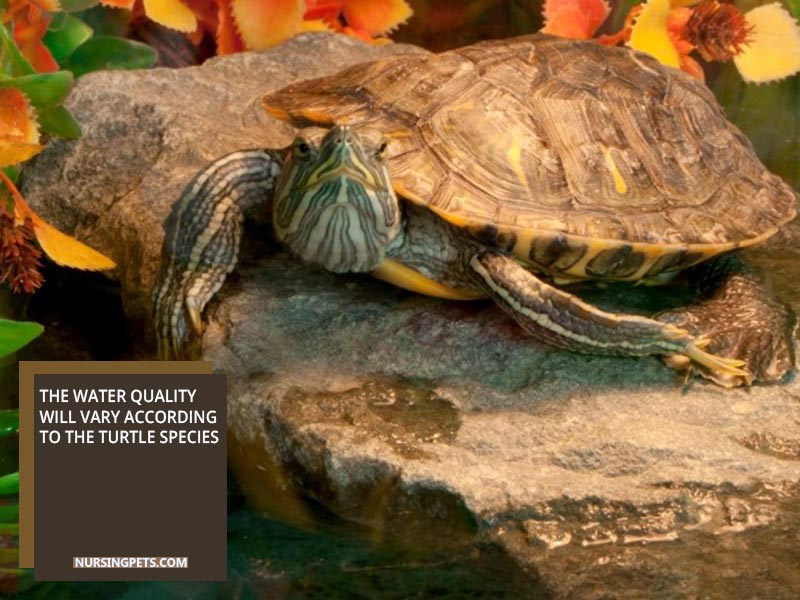
Different Turtle Species Require Different Water Quality: A variety of turtle species require different water quality for optimal health and well-being. Freshwater turtles, such as the red-eared slider and painted turtle, need water with a neutral to slightly acidic pH, while saltwater turtles, such as the green sea turtle, require water with a slightly alkaline pH.
However, below we have revealed general data on appropriate water that suits most turtle species.
pH Level: The turtle aquarium water’s pH level should be around 6 to 8. Its chlorine level needs to be 0; the same goes for the ammonia level. But the nitrite level should be slightly higher, which is 0.5 ppm.
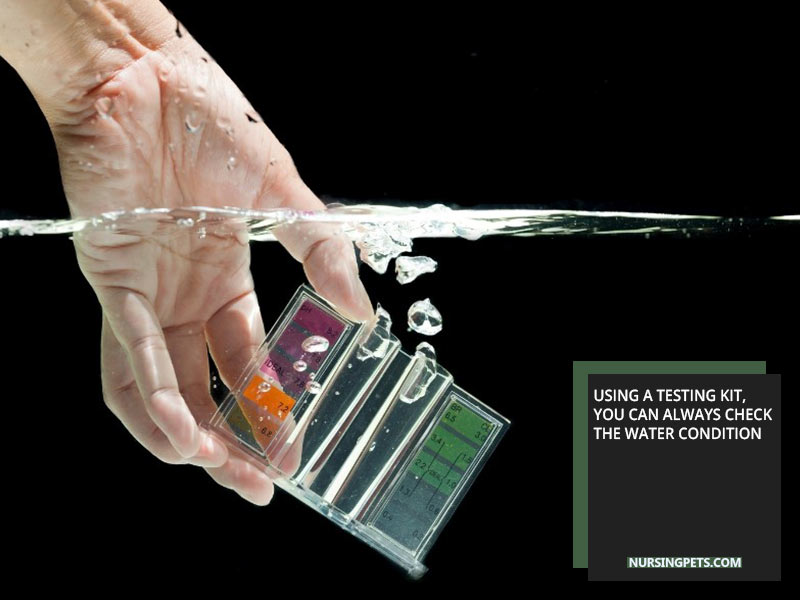
Nitrate: The nitrate level of your turtle tank water needs to be around 40 ppm or less. These chemical content values should work for 90% of pet turtles. However, if the nitrite level remains at 0 ppm, it will be better for your pet turtles.
Water Temperature: In general, freshwater turtles need water temperatures between 68 and 77 degrees Fahrenheit, while saltwater turtles require temperatures between 72 and 78 degrees.
PPM (Parts per million): The quantity of dissolved oxygen in the water is also an important factor to consider, with freshwater turtles needing at least 5 ppm and saltwater turtles needing at least 8 ppm.
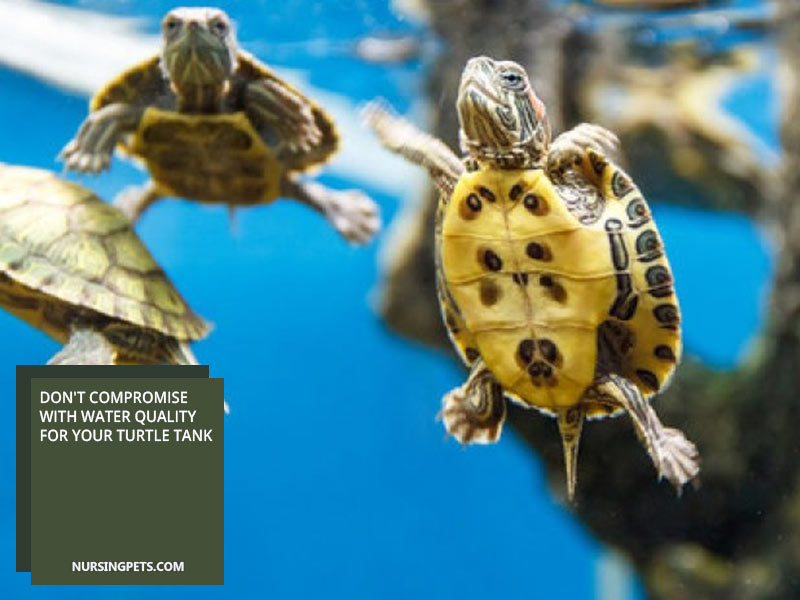
But if you find these values don’t work, you can remineralize your tank water, and how you will do it is described in another section of this content.
Clean and Safe Water: Lastly, all turtles need clean, safe water free of pollutants and contaminants. All of these factors make it important to understand the specific water quality needs of a particular species when setting up a turtle tank.
So, if your bottled water features the essential elements that suit your turtle species, you are good to pour the water into your tank. Otherwise, you should avoid using that bottled water.
Some Essential Steps to Follow When Using Bottled Water:
There are several factors you should consider while using bottled water for your turtle tank. Below, we have disclosed all of these facts. Let’s read.
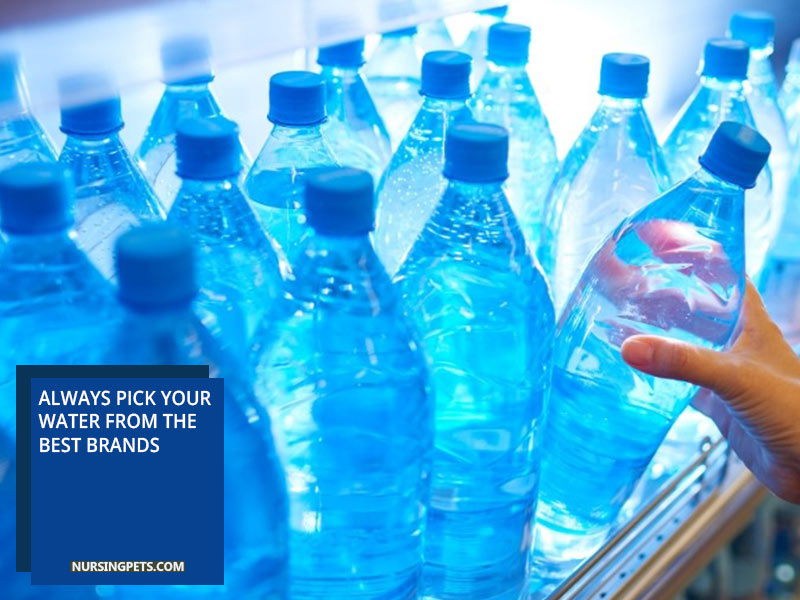
Choose the Best-Quality Bottled Water
Selecting the best bottled-water brand is crucial if you want to put bottled water in your tank. We recommend you check the chemical content of the water before buying the bottle.
You can find the description of these chemical values on the water bottle’s level. And you can grab the bottle if those values match your pet turtle’s requirements.
Test the Water Quality
Although you have read the detailed description of bottled water, you should check the water quality yourself. You can utilize a freshwater master test kit to perform the test.
Such a test kit will enable you to examine the pH level, nitrite and nitrate levels, and ammonia level of the water.

After checking the water quality, if you find everything is alright, you can put the bottled water in the aquarium and store the rest of the bottles safely (we will discuss this step later in this content).
Regrettably, if you find out the water quality isn’t promising, you can remineralize the water by following the methods we have already shared in this article.
Store the Bottled Water
Finally, after filling the turtle tank with adequate bottled water, you should store the rest safely for later use.
To store those bottles, first ensure they are capped tightly. Next, keep those bottles in a dark, clean, dry, and cool place. That’s all the factors to consider while using bottled water for a turtle tank.
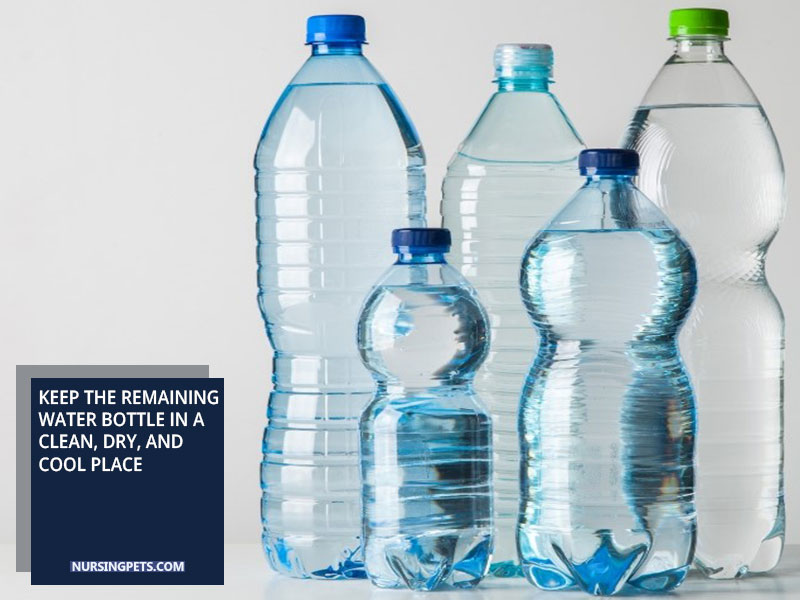
However, no matter which water source you prefer for your pet turtles, you must change the water regularly and keep the water clean. Here’s how you should perform this job.
How to Remineralize Your Bottled Water to Make It Safe for the Turtle Tank
If you don’t find any suitable bottled water brands, you can apply some techniques to remineralize your bottled water to make it suitable for your turtle tank.
For example, if you figure out the water has a too low pH level, you can add baking soda, pH increase additives, or crushed coral to raise the pH level.
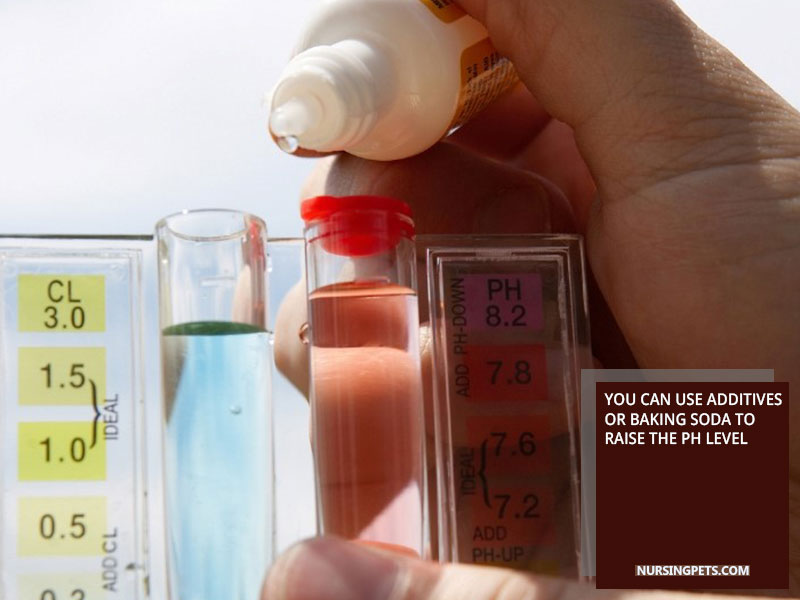
On the contrary, you can add driftwood to the aquarium or utilize peat moss in the filter to lower the pH level. Again, to eliminate chlorine and other contaminants, you can install a biological water filter and an aquarium pump.
Additionally, you can utilize several chemical additives to balance other chemical content levels, but we don’t recommend doing so. If you don’t use the correct dosage of these chemical additives, you can worsen the water condition.
Here are a few other ways and clear guides you can try-
Using RO (Reverse Osmosis)
1. Purchase a reverse-osmosis, deionization, or distillation system to filter your bottled water. It will remove chlorine, metals, and other impurities, making it safe for your turtle tank.

2. Add a remineralization filter to the water filtration system. And this will reintroduce the necessary minerals and trace elements required to maintain a safe, healthy aquarium environment.
3. Test the water with a water testing kit after installation. This will ensure that the water has the proper pH, alkalinity, and hardness levels.
4. Change the filter cartridges regularly according to the manufacturer’s instructions. This will ensure that the water remains filtered and safe for your turtle tank.

5. Add a natural aquarium buffer to the water to maintain the proper pH levels. It will ensure that your turtle tank remains safe and healthy.
Using Aquarium Salt and Water Conditioner
You can try adding a water conditioner to it to remineralize it and make it safe for the turtles. You can also try adding a small amount of aquarium salt to the water, as this will add the electrolytes and minerals that the turtles need.
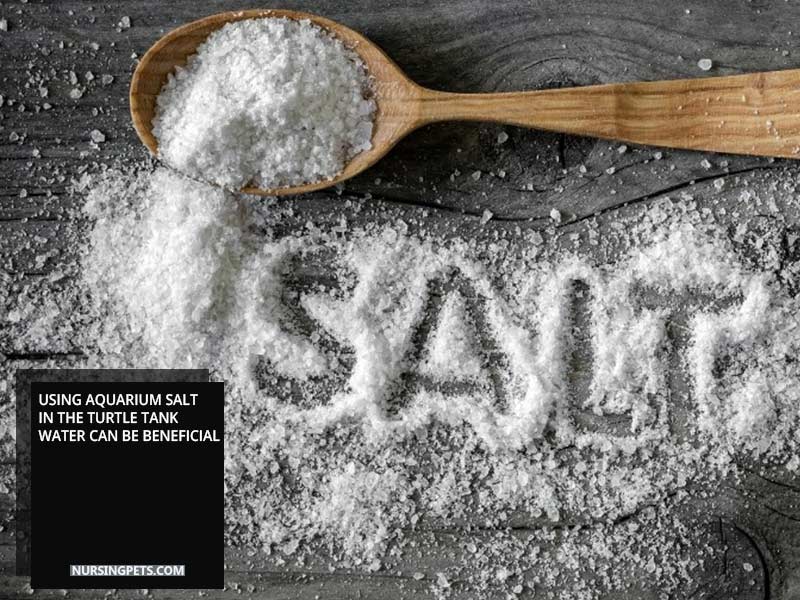
Just follow the manufacturer’s instructions and use the proper dosage, as using too much salt can harm the turtles. Here’s a detailed guide for you:
1. Add a tablespoon of aquarium salt to each gallon of water. It will add essential minerals to the water and help to bring the pH balance back to a safe level for your turtle.

2. Add a de-chlorinator to the water. And this will help to remove any chlorine or other chemicals from the water that could be harmful to your turtle.
3. Use an activated carbon filter to remove any impurities or odors from the water.

4. If the water is still cloudy, add a few drops of hydrogen peroxide. It can help to clear it up.
5. Test the pH of the water with a kit and adjust it to a safe level for your turtle. Generally, the optimum pH level for a turtle tank is between 7.0 and 8.5.

6. Allow the water to sit for 24 hours to let the chlorine and other chemicals evaporate.
7. Change out the water completely at least once a week to ensure that it is fresh and free of contaminants.
However, if you think this is too much hassle, you can switch to using alternative water sources (we have described briefly more about it in the upcoming section). So, these are some effective methods to follow to remineralize your tank water.
Benefits of Using Bottled Water in a Turtle Tank:
You can benefit significantly by putting the best-quality bottled water in your turtle aquarium. If the water you want to use features the required minerals and contains no harmful chemicals, your turtle will remain healthy and won’t catch any life-threatening diseases.
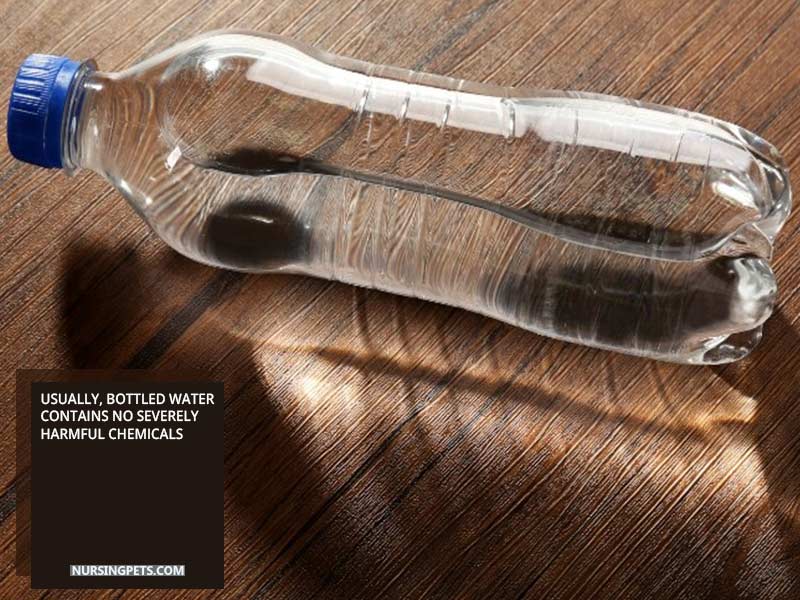
Besides, you won’t have to worry about whether your pet turtle may have shell rot or any other similar conditions. All in all, your beloved pet will be in good condition.
Drawbacks of Using Bottled Water In a Turtle Tank:
If your bottled water doesn’t come with the necessary minerals and elements, it will do nothing but harm your turtle. FYI, mostly bottled water features chlorine and fluoride, which can upset the pH balance.
Consequently, the water gets irritating to turtles, especially their eyes. Besides, these harmful chemicals can eradicate the beneficial bacteria in the turtle tank.
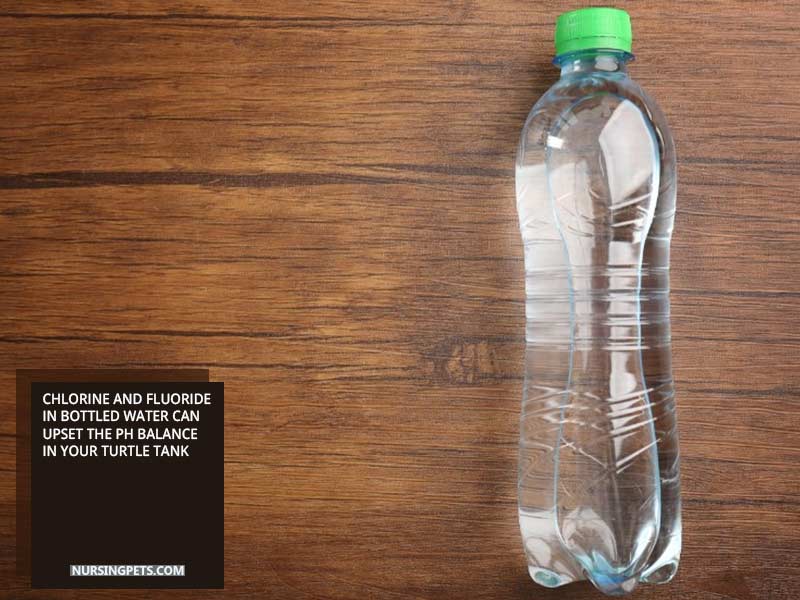
Moreover, they can affect the nitrogen cycle and hamper the breakdown of waste materials. As a result, your turtle tank water will get dirty quickly and develop algae, causing your pet to suffer from severe health conditions.
That’s why you must ensure the bottled water you want is free from unhealthy elements and features the required minerals.
Some Alternatives to Bottled Water That You Can Put in a Turtle Aquarium
If you wonder, “what kind of water should I use for my turtle tank?” your search is over, as this section covers all the necessary information on this matter. So, without delaying more, let’s read further.
Tap Water:
Instead of using bottled water, you can put tap water in the turtle tank. FYI, many turtle hobbyists prefer this option over others. However, before pouring the tap water, ensure it is dechlorinated.
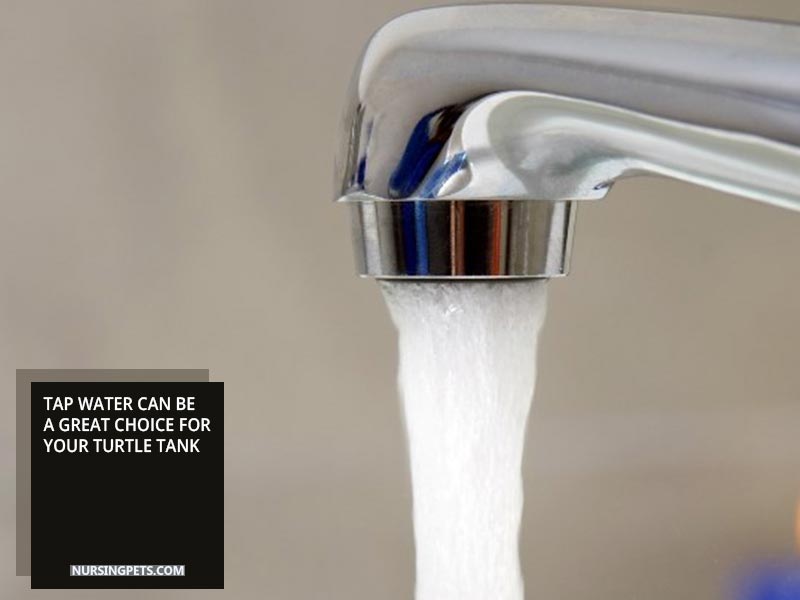
Also, you should take necessary actions if tap water lacks minerals and other elements that the turtle needs.
Distilled Water:
Distilled water is an excellent alternative to tap water as this water doesn’t contain chlorine or other contaminants found in tap water.
So, if you are searching for the answer to the question, “can I use distilled water in my turtle tank?” we hope you got it.
The significant benefit of using distilled water is that you don’t need to condition the water. But you may need to add minerals such as iron and calcium to the distilled water.
Spring Water:
Well, some people may wonder- can I use spring water for my turtle? Spring water can be another fantastic water source for your beloved turtles. But spring water is only ideal for some turtle types as it contains more minerals than other water sources.
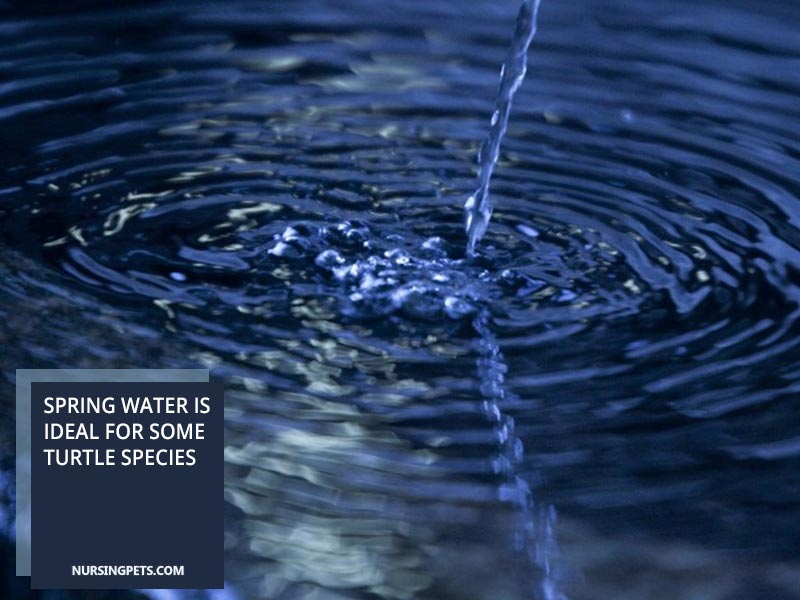
However, following the remineralization steps, you can make the spring water appropriate for your pets.
Reverse Osmosis Water:
And the last suitable water source to opt for is reverse osmosis water; we have discussed this a bit previously. Yeah, the water we usually drink. So, if you ponder, “can I use drinking water for my turtle tank?” Now you know.
However, you can install a RO unit in the tank and filter tap water. But the problem with the RO unit is that it requires regular maintenance, which can be a hassle for some people.
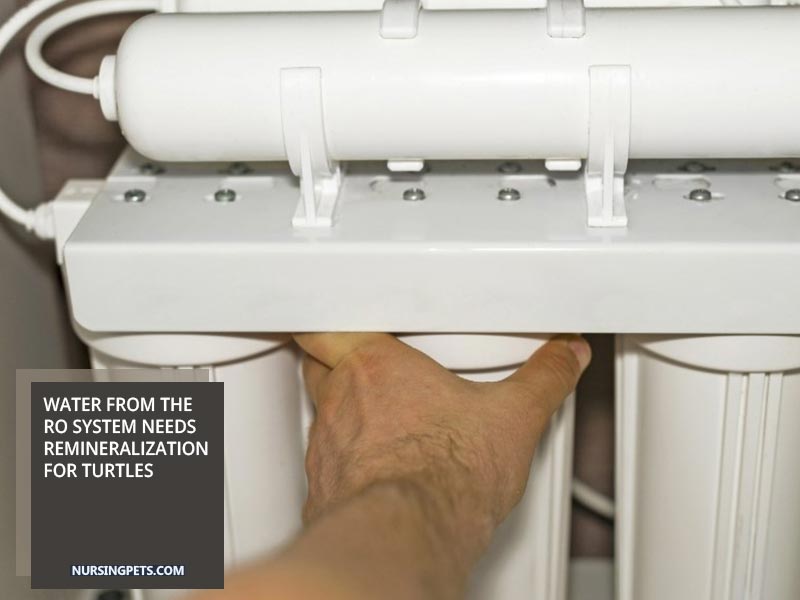
Besides, RO water lacks minerals and has a low pH level. Hence, if you can remineralize it, you can utilize this water source for your turtles.
So, these are all the alternative water sources you can put in your turtle tank. If you still want to adhere to using bottled water, you should read the upcoming section.
How To Maintain The Water Quality?
Now, if you know how to maintain the water quality in your turtle tank, you’ll need less water change and will save a lot of time and effort. So, here we mentioned techniques that can help you get/maintain crystal-clear tank water. So, let’s read them.
01. Install the Best-Quality Water Filter
We recommend installing a biological water filter. Every turtle owner knows how beneficial and essential water filtration is for turtle species. That’s why you must mount the high-grade water filter in your tank.
02. Clean Up the Leftovers
After feeding your turtle, you must clear the food leftovers using a net. Otherwise, these food remnants will decay and pollute the water. If you find removing the leftovers a hassle, you can feed turtles in a separate container.

03. Add Water Additives
You can use water additives to keep the turtle tank water clean. FYI, these water additives contain bacteria and enzymes that help dissolve poop and food remnants and facilitate water filtration.
Anyway, while choosing the water additives, ensure you pick one that is made for your specific turtle species.
04. Condition the Water
Conditioning the water is optional if you already have a biological filter installed. But if you use the best-quality water conditioner, you can expect to get the most transparent water in your tank.
05. Aerate the Water
Water aeration is quintessential if you want to discourage the anaerobic bacteria’s growth. That said, you can install an aquarium pump and an air stone to aerate the water and keep it clearer.
06. Move the Water Around
If you have a large turtle tank, you need to move the tank water around using an aquarium circulation pump. Moving the water around can help improve water filtration efficiency, diffuse bacteria, and slow down algae growth.
07. Change The Water
The final step to keep the water clear and maintain its quality is to change the tank water regularly. Now, you may wonder, “how often should I change my turtles water?”
According to experienced turtle petters, one should change the tank water at least once a week. Thus, that’s all the steps to follow to get crystal clear tank water.
Final Words
So, it’s evident that you can put bottled water in your turtle tank. Essentially, you can pour any freshwater sources if you know how to condition and remineralize them for your pets.
That’s it for this content. We hope you gained new information today through this blog post and will apply the knowledge in your petting journey. However, you may share this article and stay connected with us on Facebook, Twitter & Pinterest.
Image Source:
Information Source:

